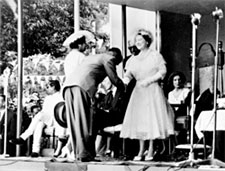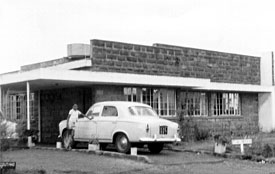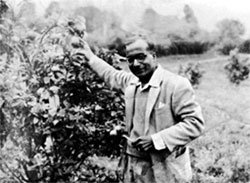
| Dedication |
|
|
| Preface |
|
|
| Contents |
|
|
| Personal
Tributes to Pascoal |
|
|
| Family Trees |
|
|
| About the Author |
|
|
| Home |
|
In 1955 Pascoal was transferred to the Ministry of African Affairs as a Section Officer to organise the Establishment's work in that Ministry. Here again his outstanding ability earned him a promotion and in July 1958 he rose to the rank of an Establishment Officer, which position he held right until retirement. He was now entrusted with the handling of all staff matters, including posting of all Provincial Administration staff that comprised of about 500 Asian personnel. Quite often Pascoal was called upon to act, for the Senior Establishment Officer, as Assistant Secretary. Presented to Royalty In 1956, Princess Margaret visited Kenya. The event was given a great deal of publicity in the colony. Tim who was then at school recalls that spectacular visit. The students were given Union Jacks and asked to line the street outside their school and wave the flags when the Princess passed.
In 1959 H.R.H. Elizabeth, the Queen Mother, visited the East African colony. Pascoal, who was then President of the Goan Institute of Nairobi, had the unique honour of being presented along with his wife Esmeralda to the Queen Mother. Reporting this singular news item the "Goan Voice" offered its heartiest congratulations to the de Mello family. First Car In keeping with his enhanced status, Pascoal purchased his first car in 1955. He selected a light grey 1952 model Morris Minor with the registration number # KBN 96. Because no-one in the de Mello family knew how to drive, the car remained in the back yard for almost a month. That is, except for occasional forays by Pascoal, accompanied by an instructor who was a good friend of the family. Tim's reminiscences reflect his reactions as an adolescent : "It was exciting to sit in our very own car. It sounded like a gentle purr. At night the dashboard lights looked wonderful. A concealed and subdued green light illuminated the ignition keyhole. It was an exciting time for us to see our Dad learn to drive. We gave him all the moral encouragement we could. He wasn't the best of drivers but he was always safe. He always seemed to struggle with the gear-shift. Looking back, an automatic transmission would have done wonders for his driving. Nevertheless, he never got into an accident and very few people can lay claim to that honour. The 1952 Morris Minor had a side valve engine. It was documented to have an eight- horsepower engine. That really was an insult to the horses. This model was notorious for its lack of power. It called for swift gear changing to negotiate tricky situations. Later, when my Dad would drive us to school from Nairobi South, he had to get off the Queen Elizabeth Highway, go round a large round-about and then negotiate a very steep incline called Ainsworth Hill. This was a daily stressful situation for us. It required a quick gear shift change down to 2nd gear. My Dad just never got the hang of this and we were embarrassed daily to see the long line of cars patiently straggling behind us, sometimes slower than walking pace! At times, he would be unsuccessful in changing down to 2nd and the car would stall. Another stressful moment. Now he had to start the car on a steep incline...." He adds a post-script. Happily, with a subsequent change to a new Morris Minor 1000, and later to a much larger car, a Peugeot 403, Ainsworth Hill no longer posed a problem to the de Mello family. Their own bungalow The four boys were growing fast, and the three rooms seemed crowded. At this stage, in keeping with a political move to placate and win support of the Asian community, the Kenya Government was handing out parcels of land to civil servants who desired to build houses and develop land. It even offered further incentives by way of subsidized loans at meagre interest rates. The allotted area was called Nairobi South. Unlike the vast majority of Goans who were content with living in quarters or rented houses, Pascoal with his usual foresight decided to take full advantage of the scheme. He selected a plot on the outskirts of Nairobi. It was virgin land bordering the Kenya National Park. At night it was not uncommon to see zebra and wildebeest roam about freely - particularly if a lion was on the prowl! Quite often, dogs in the neighbourhood fell victim. To erect his own house Pascoal enlisted the services of Bhalla & Thakore, the firm of architects that had designed the Nairobi Goan Institute. Scottish-trained Thakore was personally known to Pascoal through his involvement with that construction. The work was entrusted to the contractor, Karam Singh. Keeping in mind financial constraints, the end result was a compact and practical three-bedroom house with provision for an additional storey to be added anytime later.
The de Mello residence in Nairobi The modern three-bedroom bungalow had the Living/Dining room based on the open concept. Lighting was cleverly concealed. The bedroom furniture was all built-in, made from highly polished wood. To complement the closets, the Living/Dining space was done in parquet flooring, laid out in herring-bone style. The rest of the house had terazzo floors. As soon as their house was completed, the de Mello family moved in. For Pascoal and Esmeralda, to have their very own place built exactly as they chose, was nothing less than a dream come true!! They lived in it, basking in their good fortune, for the next 18 years. And time proved the wisdom of their investment.
Pascoal samples fruit at Padhiyar's farm in Nyeri | ||||
|
 Pascoal was one of the few Asian dignitaries to be
presented to Her Royal Highness. Commenting on this dramatic event,
"Goan Voice", the community newspaper proudly proclaimed: "The
honour is indeed very much appreciated by the Community and
represents official recognition of the long services which Goans
have rendered the country and its Government during many
generations."
Pascoal was one of the few Asian dignitaries to be
presented to Her Royal Highness. Commenting on this dramatic event,
"Goan Voice", the community newspaper proudly proclaimed: "The
honour is indeed very much appreciated by the Community and
represents official recognition of the long services which Goans
have rendered the country and its Government during many
generations."
